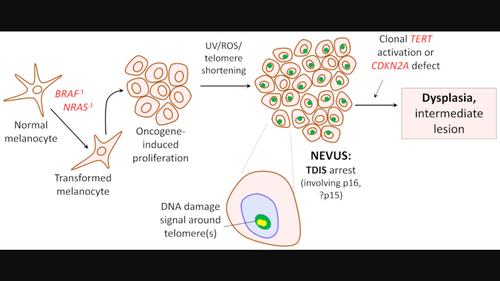当前位置:
X-MOL 学术
›
Pigment Cell Melanoma Res.
›
论文详情
Our official English website, www.x-mol.net, welcomes your feedback! (Note: you will need to create a separate account there.)
Review: Are moles senescent?
Pigment Cell & Melanoma Research ( IF 4.3 ) Pub Date : 2024-02-15 , DOI: 10.1111/pcmr.13163 Dorothy C. Bennett 1
Pigment Cell & Melanoma Research ( IF 4.3 ) Pub Date : 2024-02-15 , DOI: 10.1111/pcmr.13163 Dorothy C. Bennett 1
Affiliation

|
Melanocytic nevi (skin moles) have been regarded as a valuable example of cell senescence occurring in vivo. However, a study of induced nevi in a mouse model reported that the nevi were arrested by cell interactions rather than a cell-autonomous process like senescence, and that size distributions of cell nests within nevi could not be accounted for by a stochastic model of oncogene-induced senescence. Moreover, others reported that some molecular markers used to identify cell senescence in human nevi are also found in melanoma cells—not senescent. It has thus been questioned whether nevi really are senescent, with potential implications for melanoma diagnosis and therapy. Here I review these areas, along with the genetic, biological, and molecular evidence supporting senescence in nevi. In conclusion, there is strong evidence that cells of acquired human benign (banal) nevi are very largely senescent, though some must contain a minor non-senescent cell subpopulation. There is also persuasive evidence that this senescence is primarily induced by dysfunctional telomeres rather than directly oncogene-induced.
中文翻译:

评论:痣会衰老吗?
黑素细胞痣(皮肤痣)被认为是体内发生细胞衰老的一个有价值的例子。然而,一项针对小鼠模型中诱导痣的研究报告称,痣是通过细胞相互作用而不是像衰老这样的细胞自主过程来阻止的,并且痣内细胞巢的大小分布不能用癌基因的随机模型来解释- 诱导衰老。此外,其他人报告说,一些用于识别人类痣细胞衰老的分子标记也在黑色素瘤细胞中发现,而不是衰老细胞。因此,人们质疑痣是否真的会衰老,这对黑色素瘤的诊断和治疗具有潜在的影响。在这里,我回顾了这些领域,以及支持痣衰老的遗传、生物学和分子证据。总之,有强有力的证据表明,获得性人类良性(平庸)痣的细胞大部分是衰老的,尽管其中一些必须含有少量的非衰老细胞亚群。还有令人信服的证据表明,这种衰老主要是由功能失调的端粒引起的,而不是直接由癌基因引起的。
更新日期:2024-02-20
中文翻译:

评论:痣会衰老吗?
黑素细胞痣(皮肤痣)被认为是体内发生细胞衰老的一个有价值的例子。然而,一项针对小鼠模型中诱导痣的研究报告称,痣是通过细胞相互作用而不是像衰老这样的细胞自主过程来阻止的,并且痣内细胞巢的大小分布不能用癌基因的随机模型来解释- 诱导衰老。此外,其他人报告说,一些用于识别人类痣细胞衰老的分子标记也在黑色素瘤细胞中发现,而不是衰老细胞。因此,人们质疑痣是否真的会衰老,这对黑色素瘤的诊断和治疗具有潜在的影响。在这里,我回顾了这些领域,以及支持痣衰老的遗传、生物学和分子证据。总之,有强有力的证据表明,获得性人类良性(平庸)痣的细胞大部分是衰老的,尽管其中一些必须含有少量的非衰老细胞亚群。还有令人信服的证据表明,这种衰老主要是由功能失调的端粒引起的,而不是直接由癌基因引起的。



























 京公网安备 11010802027423号
京公网安备 11010802027423号